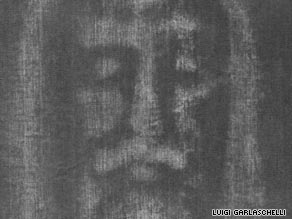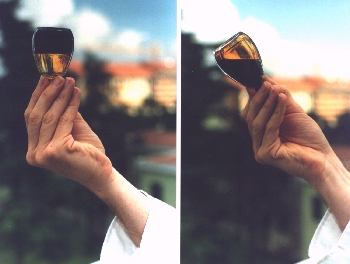 Radiocarbon dating [c.f. P.E. Damon et al: Radiocarbon dating of the shroud of Turin, Nature 337, 611-615, 1989] shows that the shroud was made during the middle ages. Nevertheless, believers claim that the carbon measured by scientists was due to some fire deposits. They claim that Basically the shroud has some strange properties and characteristics that cannot be reproduced by human hands. But, a few days ago, a professor of Organic Chemistry, Luigi Garlaschelli, announced that he managed to create a copy of the shroud by wrapping a specially woven cloth over one of his students, painting it with pigment, baking it in an oven (which he called a "shroud machine") for several hours, then washing it.
Radiocarbon dating [c.f. P.E. Damon et al: Radiocarbon dating of the shroud of Turin, Nature 337, 611-615, 1989] shows that the shroud was made during the middle ages. Nevertheless, believers claim that the carbon measured by scientists was due to some fire deposits. They claim that Basically the shroud has some strange properties and characteristics that cannot be reproduced by human hands. But, a few days ago, a professor of Organic Chemistry, Luigi Garlaschelli, announced that he managed to create a copy of the shroud by wrapping a specially woven cloth over one of his students, painting it with pigment, baking it in an oven (which he called a "shroud machine") for several hours, then washing it. The blood of St Gennaro: St Gennaro is the patron saint of Naples. Faithful gather three times a year to witness the alleged liquefaction of a sample of his dried blood kept in a sealed glass ampoule. We know little about St Gennaro's life who lived in the 3d c. CE. According to legend, his blood was saved by a woman called Eusebia just after the saint's death. During the liquefaction ceremonies, the archbishop holds up the vial and tilts it again to demonstrate that liquefaction has taken place. (There is a procession which makes its way through streets lined with shops selling religious items.) The announcement of the liquefaction is greeted with a 21-gun salute at the 13th-century Castel Nuovo. The ampoules remains exposed on the altar for eight days, while the priests move or turn them periodically to show that the contents remains liquid. During this time, the faithful kiss the ampoule. (But, recently, they stopped the kisses due to swine flu fears.)
The blood of St Gennaro: St Gennaro is the patron saint of Naples. Faithful gather three times a year to witness the alleged liquefaction of a sample of his dried blood kept in a sealed glass ampoule. We know little about St Gennaro's life who lived in the 3d c. CE. According to legend, his blood was saved by a woman called Eusebia just after the saint's death. During the liquefaction ceremonies, the archbishop holds up the vial and tilts it again to demonstrate that liquefaction has taken place. (There is a procession which makes its way through streets lined with shops selling religious items.) The announcement of the liquefaction is greeted with a 21-gun salute at the 13th-century Castel Nuovo. The ampoules remains exposed on the altar for eight days, while the priests move or turn them periodically to show that the contents remains liquid. During this time, the faithful kiss the ampoule. (But, recently, they stopped the kisses due to swine flu fears.) In an article published by Luigi Garlaschelli et al. [c.f. L. Garlaschelli, F. Ramaccini and S. Della Salla: The blood of St Januarius, Chemistry in Britain 30, 2, 123 , 1994], the authors announce that they can replicate the liquefaction phenomenon and conclude that:
In an article published by Luigi Garlaschelli et al. [c.f. L. Garlaschelli, F. Ramaccini and S. Della Salla: The blood of St Januarius, Chemistry in Britain 30, 2, 123 , 1994], the authors announce that they can replicate the liquefaction phenomenon and conclude that:Further tests to investigate the real nature of the holy "blood" without opening the ampoule come readily to mind: for example, molecular absorptions and fluorescence spectroscopy, and Raman scattering measurements, made with modern electronic instruments by qualified spectroscopists. Controlled temperature increments and shock tests also represent non-destructive analytical methods by which our or alternative hypotheses might be verified or disproved. Whether these simple tests will be allowed to go ahead wholly depends upon the Catholic Church. At present however, given that the phenomenon has been replicated, it would be rather too naive to consider it irreproducible or unexplainable.

CONCLUSION:
-- Has science proved that these centuries' old "miracles" are reproducible?
Well, yes!
-- Will that stop any of the faithful from believing in them?
Not at all. As is usual in these cases, those who believe will believe even more strongly. In religious matters, it doesn't matter what you prove or not. Whoever wants to believe he or she will believe no matter what. For them, proofs, science and logic are utterly irrelevant.




No comments:
Post a Comment